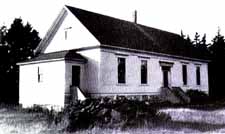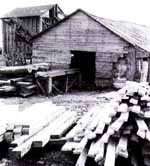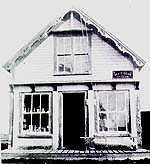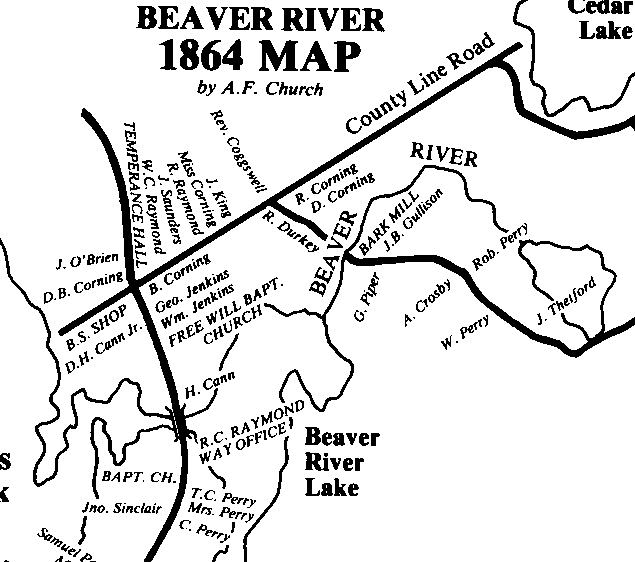Early Settlers

Beaver River was originally named either Elsetcook, a Mi'kmac word
meaning "Flowing by high banks" or Wesek, "the Beaver's Home". The original
surnames included Landers, Pitman, Sanders, Crosby, Patten, Cann,
Goudey, Perry, Jeffrey, Tedford, Corning, Killam, Trask, Blackadar, Byrnes,
Phillips, Kelley, Porter, and Sollows (List from "Brown's History of Yarmouth
County"), of which many are still quite common throughout Yarmouth Town
and County.
The first of these settlers came to Beaver River by 1761 and about
97% of them were the offspring of the New England families settling
in Chebogue. According to stories handed down by pioneer families, the
settlers travelled to Beaver River from the Cape Forchu-Overton area in
small boats and landed near where Temperance Hall now stands but the precise
date of this landing is not known. These settlers were squatters on Crown-owned
lands and, after doing all the work to build their settlement and homes,
they wanted the land to be theirs legally. On July 6, 1814, six of the
settlers petitioned Sir John C. Sherbrook, the Lieutenant-Governor of Nova
Scotia, for land. The petition read:
"The petition of Johnathan Corning Sr.; Johnathan Corning Jr.;
Josiah Porter; Ashael Corning; Daniel Corning and William Perry humbly
showeth: The four of your petitioners have familys consisting of three
to eight children, and the last two are young
men acting for themselves without families. That neither
of them have ever recieved any grant of land from Government and that they
are in want of land to settle themselves thereon. They therefore, pray
that your excellency may see fit."
On the back of the petition the Surveyor General, Charles Morris,
had signed and written that: "These petitioners are reputed to be industrious
farmers and as such merit favorable consideration." And Samuel S. Poole
wrote "I do certify that these petitioners before named are good subjects
and industrious men , and the facts stated in the petition are true, and
therefore recommend their petitions to a favourable conclusion."
 It
wasn't until thirteen years later, December 27, 1827, that they finally
received their land grants and having received legal rights to their land,
the settlers continued to improve their settlement. The major structures
of Beaver River were the two sawmills which were powered by Bartlett's
Brook and Beaver River, one built and owned by Josiah Porter and one built
jointly by the community which belonged to all who helped build it.
By 1829, 68 years after the first settlers arrived, Beaver River was fairly
well settled though it was never an Acadian settlement. (It has been
said that 'outsiders' were not made welcome.) It
wasn't until thirteen years later, December 27, 1827, that they finally
received their land grants and having received legal rights to their land,
the settlers continued to improve their settlement. The major structures
of Beaver River were the two sawmills which were powered by Bartlett's
Brook and Beaver River, one built and owned by Josiah Porter and one built
jointly by the community which belonged to all who helped build it.
By 1829, 68 years after the first settlers arrived, Beaver River was fairly
well settled though it was never an Acadian settlement. (It has been
said that 'outsiders' were not made welcome.)
Building material in Beaver River was mostly wood and stone, which
were plentiful, but they also had two brick-making kilns. Glass must have
been a problem to get though because every newspaper report on damage
quoted the number of panes of glass broken. In years gone by Beaver
River has had its share of hardships, as we can see from these newspaper
articles, which date back to the 1800's.
Manuscript concerning the Beaver River
fire of 1820, written by Reuben M. Raymond in 1844:
 "A
short account of a fire that swept through Beaver River Sept. 11th, 1820,
that burned every house but three for three miles distant, burned our two
saw mills and one grist mill. That was all the mills we had, and burned
all the hay barns and grane and the most of the cattle and pigs and burned
all and everything the people had in their houses. They barely escaped
with their lives in the clothes they had on them. There was much
of the place then not cleared of woods. As the fire came on the wind blew
a perfect hurricane. It was just at dusk and the fire came on so
unawares with smoke and darkness the people could take nothing but
their children and run for life. Some for the lake and some for the sea
shore and in their haste some families were separated, not having
time to say anything but each to run the way they thought best, and for
the want of one moment of time one little boy burned to death.
There being so much forest at that time besides the building to burn, it
is most impossible for anyone to imagine that has not seen the like. What
a sea of fire rowling along with the greatest speed. The writer of this
was in the scene and in attempting to escape the fire, it went so fast
that it got ahead of me, so there was no getting out through the fire.
I expected to do my best I should be burned to death, but the thought was
to preserve life as long as possible. I had turned back to find a place
where the wood was mostly burned away, and there remained in that cloud
of smoke through most of the night and only by God's mercy and miracle
that my life was preserved. By two o'clock in the morning the wind abated
and then I could hear the prayers of some of my neighbours, who had got
into the lake for safety, ascending to the God that rules the tempest.
Then I could thank the Lord God that some lives were saved if not all.
But what a scene in the morning, everything burned up.We began to meet
and as I met one man he says O deare I fear my companion is gone.
Each had to flee for life in the darkness and knowing not which way the
other took, but she too was safe and there were many happy meetings that
day as people came together and they mourned the loss of the little boy
that was burned up but they praised and thanked the Lord for their deliverance." "A
short account of a fire that swept through Beaver River Sept. 11th, 1820,
that burned every house but three for three miles distant, burned our two
saw mills and one grist mill. That was all the mills we had, and burned
all the hay barns and grane and the most of the cattle and pigs and burned
all and everything the people had in their houses. They barely escaped
with their lives in the clothes they had on them. There was much
of the place then not cleared of woods. As the fire came on the wind blew
a perfect hurricane. It was just at dusk and the fire came on so
unawares with smoke and darkness the people could take nothing but
their children and run for life. Some for the lake and some for the sea
shore and in their haste some families were separated, not having
time to say anything but each to run the way they thought best, and for
the want of one moment of time one little boy burned to death.
There being so much forest at that time besides the building to burn, it
is most impossible for anyone to imagine that has not seen the like. What
a sea of fire rowling along with the greatest speed. The writer of this
was in the scene and in attempting to escape the fire, it went so fast
that it got ahead of me, so there was no getting out through the fire.
I expected to do my best I should be burned to death, but the thought was
to preserve life as long as possible. I had turned back to find a place
where the wood was mostly burned away, and there remained in that cloud
of smoke through most of the night and only by God's mercy and miracle
that my life was preserved. By two o'clock in the morning the wind abated
and then I could hear the prayers of some of my neighbours, who had got
into the lake for safety, ascending to the God that rules the tempest.
Then I could thank the Lord God that some lives were saved if not all.
But what a scene in the morning, everything burned up.We began to meet
and as I met one man he says O deare I fear my companion is gone.
Each had to flee for life in the darkness and knowing not which way the
other took, but she too was safe and there were many happy meetings that
day as people came together and they mourned the loss of the little boy
that was burned up but they praised and thanked the Lord for their deliverance."
Lightning Strikes a Beaver River Home
"On Monday forenoon, August 10, 1863, the lightning struck the house
of Mr. George Sollows, Beaver River, and did much damage. Miss Sollows,
who was passing upstairs at the time, carrying a pot, was knocked senseless
to the floor and pieces of the pot were scattered in all directions. The
house was shattered and no less than 70 panes of glass were broken."
The Blacksmith Shop: By an unknown writer
"How well I remember the blacksmith shop in Beaver River, it's massive
brick forge and wide chimney, with a hogshead tub of water in front
in which to temper steel. The huge leather bellows with it's long
lever which the blacksmith used to operate by laying his arm on it and
pressing it down. That caused the bellows to close and expell a powerful
draft. When the lever was released the bellows would open and refill with
air. Then the anvil, only a step away from the forge, and a rack on the
wall with many different kinds of tongs. On the other wall, racks of horseshoes
of different sizes all complete and ready for use. On racks overhead were
long bars and rods of iron to be worked into anything needed. The Blacksmith
was Philip Doty. He was elderly as long as I knew him. He had
a bushy full grey beard, and was nearsighted. He wore thick glasses, and
often when we youngsters watched him work we used to think he was going
to burn his nose peering so close to red hot metal!! There was a heavily
built rack not far from the door where he shod horses and oxen. It had
a heavy canvas sling operated by levers, so that a horse or ox was raised
off it's feet in the sling under it's belly, like in a hammock. The animals
head was fastened loosely so it could not thrash around and the canvas
sling was bound with very heavy rope so it would stand a great strain.
The animals legs or feet were bound with strong ropes on racks, part of
the main rack, so that no matter what the animal did, it could never move
a foot while the smith was working on it. We used to watch closely every
move the smith made when he was shoeing an animal. He wore
a heavy cow hide apron in all his work. Our favorite sight was to watch
him take a piece of sizzling white-hot metal from the forge and start to
hammer it into shape and the red-hot sparks would fly in all directions.
Sometimes when we stopped on our way home from school there was nothing
interesting going on. Those times we didn't stay long. The front door to
the shop was quite wide and always open, so a glance would show us whether
it was worth stopping or not. Mr. Doty also had the post office in his
home just diagonally across the street, so that Mrs. Doty could call him
for meals. She operated the post office in 1890-1910. They were both very
good people, and Philip was considered a first class smith in the whole
country round. "
|

